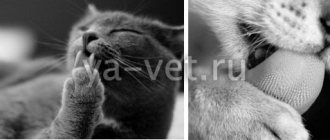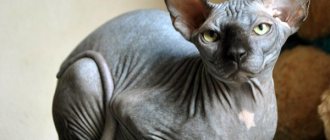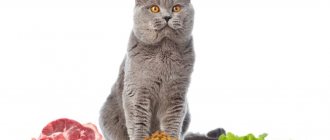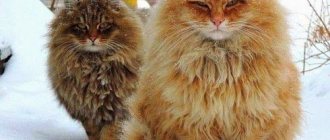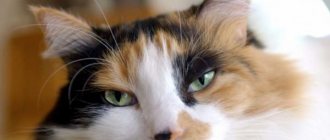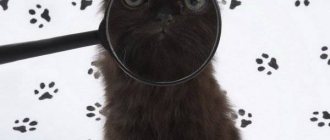Original haircuts for pets have gained great popularity among many owners, but at the same time they have the same number of opponents. Veterinarians say that frequent haircuts are harmful to cats and your pet should be cut only when necessary, and not for your own pleasure. Animals do not always react calmly to this procedure; they may develop depression and even skin diseases. But many are still interested in the question of whether it is possible to cut cats and how often it should be done.
Why cut your cat's hair?
The main purpose of grooming animals is to care for their fur.
Cats have a natural need to constantly care for their fur coat. But very often this is not enough, especially for fluffies with a fur length of more than 3 cm. Special care is recommended for such pets, including regular combing, removing tangles and trimming excess hair.
Cat trimming procedure
The cat trimming procedure consists of the following steps:
- It is necessary to fix the pet in a position lying on its side, holding it by the hind and front legs.
- First of all, the tangles are cut off with scissors. After this, they continue cutting the hair on the sides of the body and back using a clipper.
- When trimming fur from the belly, you should carefully avoid the nipples and intimate areas. Experts recommend first cutting the hair in intimate areas with scissors and then completing the manipulation with a clipper. It must be remembered that cats' skin is very thin and easily injured. Therefore, while working with the machine, you need to tighten it so that skin folds do not get under the blades.
- At the end of the procedure, the cover on the paws is cut off.
- The hair on the animal's head is not trimmed; it is possible to shape it with thinning scissors. It is strictly forbidden to trim the mustache, as it is an important organ of touch.
- Tail trimming is carried out at the request of the owner.
If you can’t cut your cat’s hair in one procedure, you can divide it into several stages. This will allow the pet to avoid unnecessary stress, and the master from bites and scratches.
After grooming, the animal must be bathed and dried with a hairdryer. If your cat is afraid, you can remove cut and stuck hairs by wiping it with a damp cloth or chamois cloth. During the cold season, you should create a comfortable microclimate without drafts in the room where the pet is.
In what cases is it contraindicated?
Experts note the three weakest areas, where hair removal can be dangerous for your pet:
- Paws, especially their lower part
- Tail, but model treatment of the last third of the organ is allowed
- head
Experts have an extremely negative attitude towards total haircuts. The optimal hair length, if you really want or need treatment, is 0.5 - 1 cm. The hair will no longer bother the owners, and the protective layer is preserved.
The naked animal should be covered with a cotton cloth to avoid direct exposure to sunlight. This will avoid burns or prevent the development of cancer.
It is important to understand that the lack of hair can negatively affect a cat's psyche and communication. Apathy, loss of appetite, ignoring the owners are not uncommon situations after a total haircut.
In addition, wool is one of the main tools in the fight for territory or a female. A naked animal may simply not be perceived by competitors. The situation is especially relevant for owners of private houses. A cat that has lost a war for territory several times will be afraid of its rivals, “invite” it to visit and even share food. Often the neighbor's cat will completely take the loser's food away.
IMPORTANT! Due to hypothermia after cutting, in some places the hair often does not grow back. You should carefully monitor your pet's heat exchange, especially in winter and autumn.
Required Tools
A hygienic grooming of a furry pet can be done using only scissors as the main tool. Naturally, they should have rounded ends, be well sharpened and not very large in size.
But it is preferable, of course, to use a trimmer (a special hair clipper). It is completely safe and you won’t be able to inadvertently injure your pet, and it does the job much faster and easier. The only problem that can become an obstacle is the noise the machine makes. Your pet may get scared of the device and simply run away. There are regular trimmers and ones for hard-to-reach places.
Additionally you will need:
- Comb with rounded teeth to avoid scratching the animal.
- Hydrogen peroxide and cotton wool in case you accidentally injure your pet.
- Bedding, for example, an old towel, which will have to be thrown away after the event.
- A table or couch is any horizontal surface where you can comfortably place your cat.
- A distracting object that the pet can engage in during the procedure, for example, a toy, a dental bone.
Which machine to choose for grooming a cat
Retail chains offer a very wide range of devices for grooming pets, from very expensive and functional to budget ones. The disadvantage of inexpensive models is, first of all, their unstable and indelicate operation - such models can cut fur poorly or pull out hair. Another disadvantage of budget models is that they overheat during use, and you can simply burn your pet. Inexpensive trimmers have a short service life.
As mentioned above, there are regular trimmers and ones for hard-to-reach places. The latest models are distinguished by their small size and shorter blades (no more than 2 cm). A similar device can be used to treat areas of anatomical curves, ears, muzzle, and areas under the tail. But this is more of an auxiliary tool; it is impossible to give a full haircut with it. Conventional trimmers are used for these purposes.
For representatives of especially fluffy breeds with a thick undercoat (Persians, exotics, etc.), choose devices with a power of at least 45 W, they will not overheat and can cope with thick hair. Pay attention to the blades: they should be wide and sharp. The speed and delicacy of the work depends on the sharpness of the blades. For cats with not very thick and long hair, you can use clippers with a power of 20 W or more.
A very useful option for the trimmer is the ability to automatically adjust the cutting surfaces. When choosing a device in a store, pay attention to this; not all models have this function. With a minimum length of cutting surfaces of 0.5 cm, the length of the pet's hair after cutting will be equal to 0.5 cm. It is dangerous to use devices with very small blades yourself at home - you can injure the animal's skin.
Mains-powered electric trimmers are preferable to those that rely on batteries or a battery. They guarantee stable and long-term operation of the device. If you frequently have to pause and turn off the device while cutting, the battery or batteries may drain very quickly. An even more convenient option is models that have both a battery and a network connection. The noise level produced by the device is also important. The quieter and more pleasant the device is, the more the cat will like it.
Make sure that the machine is comfortable to hold in your hands. It should be moderately light and moderately heavy. It is difficult to ensure smooth movement with a device that is too light, and a device that is too heavy will quickly tire your hand. Therefore, try to find a “golden mean”.
Pay attention to the shape of the handle; it should fit comfortably in your hand and not slip out.
Be sure to check the device before purchasing, especially for overheating and foreign odors.
Does a cat need a summer haircut?
You can, of course, help fight the heat this way. But will your pets thank you for this?
Photo: PHOTOXPRESS
It all started with a post on Facebook. A friend reported: “With trepidation I imagine Kisa in a new image. My wife cut my hair while I was away. Because she was suffering from the heat and the wool was already hanging in the air of the apartment. In the special salon they warned that Kisa was very comfortable this way, but under no circumstances should you laugh at her. Otherwise, psychological trauma is possible. And indeed, Kisa is very pleased, but sometimes she looks inquisitively. How, they say? We assure her that she is the most beautiful cat in the world. (But funny - creepy.).” And then there’s a photo of a short-haired Kitty with a fluffy ball at the end of her tail.
Immediately there were comments: you can’t cut her hair like that, she has vibrissae (tactile hairs with nerve endings) all over her body, so the cat after such a procedure is a tactile-sensory disabled person. After all, they are on the paws too, and all over the body. And the biggest ones are on the face.
ANIMAL BARBER
This discussion really excited me for the following reason: the other day I cut my guinea pig Vasya’s hair. Also for reasons of humanism: it’s summer after all, the little one will get some relief. Vasily is long-haired, his sides are seriously matted and “overgrown” with tangles. Also a good reason for a haircut. I cut my hair, and then got scared: what if I can’t? What if guinea pigs also have these, what’s their name... vibrissae?
And in order to find out everything and not be afraid anymore, I called Alexander Petrov, a veterinarian at the Animal Repair clinic:
“Animals can be safely cut; it won’t hurt them.” Even cats. In summer, a hygienic haircut is sometimes even necessary. After all, the wool becomes matted, diaper rash appears, and also tangles in which parasites appear. The worst thing that can happen from a haircut is skin irritation from the hairdressing clipper. But it will pass. And the animal may also feel uncomfortable immediately after the procedure, when the cut fur is prickly. Therefore, we recommend that you wash your pet after grooming.
Another important advice from the veterinarian: after a very short haircut, protect the bare skin of your four-legged friend from the sun. Cover with a cape and do not let it out into the open sun. When the fur grows to 3 - 5 mm, sunburn is no longer a problem.
Comfortable and not hot
It is especially difficult in the summer for furry animals - Persian cats or Spitz dogs; it is even recommended to cut them. Dogs are usually scheduled to see a groomer (animal hairdresser) once every 2-3 months, cats - a little less often. Cats are also often brought in to be combed (after this procedure, the apartment will be free of fur for a couple of weeks).
“Rarely does a dog or cat get a haircut with pleasure,” says Natalya Yamshchikova, groomer at the Ricci salon. “We try to “come to an agreement,” communicate, reassure, sometimes we put a muzzle on the dog, a collar on the cat and wrap its paws, asking the owner to hold the pet. My advice is to get your animals cut in a salon. At home they are the masters and begin to defend the territory, but in the cabin they are calmer. And remember that for a dog or cat, any procedure - cutting, coloring, combing - is a serious stress, so be there to calm your pet.
You may be laughing: stress? in dogs and cats? But in vain, by the way. Look at the shorn animal: at first he behaves like a person who finds himself naked on the street. Then, however, he gets used to his new appearance.
Poodle is a lion
Poodles provide the greatest scope for dog barbers: even the standard show haircut (with a “lion’s” mane and pompoms on the tail) looks very extravagant, and there are also options for treating paws and ears... But if for poodles this is all in the order of things, then, Let's say a short-haired chow-chow looks, frankly, stupid. And, apparently, she understands this very well. It is not recommended to cut some dogs, no matter how hot it is: bobtails, collies. But spaniels, West Highland terriers, and Yorkies still have to be taken into the hands of groomers from time to time, so in the summer they can simply be cut shorter than usual.
Features of grooming cats of popular breeds
In most cases, the type of haircut is determined by the breed of the cat. Below are haircuts for the most common breeds.
British Shorthair
British Shorthair
Nature has endowed true Britons with short, silky hair that is not prone to matting, so experts generally do not recommend cutting representatives of this breed.
If the pet is provided with proper and proper care for its coat in the form of regular combing out of excess fibers with rubber or bristle brushes, it will have an attractive appearance without any hairstyle.
Persian
Persian cat
Persian cats are known for their long and fluffy hair, which quickly forms tangles. That's why they need the services of cat groomers the most.
Despite their sedate and docile nature, such animals tolerate haircuts very poorly. These cats need to be trimmed together with an assistant, especially if this procedure is being done for the first time in their life.
The classic hairstyle for Persian cats is “Puss in Boots.” The procedure begins with cutting the fur from the sides of the body, then from the back and abdomen.
To avoid injuring the animal, experts advise using a clipper with a 3 mm attachment.
The fur on the head, tail and paws is left untouched, sometimes the tail is cut in half with scissors or a tassel is formed at the end.
Upon completion of the manipulation, the cat must be bathed or wiped with a damp cloth.
Siberian breed
Siberian cat
For representatives of the Siberian breed, haircut options can be any; these cats cannot be spoiled by outlandish hairstyles.
The structure of the fur of Siberian cats is very similar to human hair, and the more often and shorter it is cut, the better quality it becomes.
The most popular haircuts for this breed are French Lion, Dragon and Plush.
Hygienic care for dogs in animal salons and veterinary clinics in Rostov-on-Don
By regularly grooming your dogs, you can easily keep your pet tidy and clean. If you periodically forget to do this, mats of fur will form on the animal’s body, interfering with its movement. Through such hairballs, air access to the pet’s skin is blocked, skin parasites settle on it and various diseases develop, and irritation appears. The problem is especially pronounced in Yorkshire terriers and poodles - these are the dog breeds that most often become clients of professional groomers. The dog grooming service includes:
- Combing or removing tangles from the fur of a four-legged pet.
- Shortening the hair on the ears, muzzle and beard.
- Trimming hair between nails, paw pads and around intimate areas.
- Trimming claws.
- Cleaning the paranal glands and ears.
- Washing the dog if necessary.
- Removing ear hairs if the breed is predisposed to their appearance.
All these procedures are necessary for dogs. Dirt and tangles cause serious inconvenience to animals. Dirty and matted fur constantly pulls on the skin, causing a painful sensation. The pet begins to constantly itch, eczema and diaper rash appear under the fur.
Hygienic grooming of dogs is performed using scissors or clippers, depending on the wishes of the owner. Dirty fur is not cut, so work with tools begins only after the animal has first been bathed. As a rule, dogs tolerate this procedure calmly, so the presence of the owner is not a mandatory requirement.
How often should a cat be groomed?
The frequency of trimming depends on the cat's coat type, breed, and health. Hair growth to its previous length in animals of different breeds occurs from several months to 1 year, on average about 6 months.
According to the recommendations of veterinarians, hygienic grooming of long-haired and fluffy cats should be carried out no more than 3-4 times throughout the year. For other pets, 1–2 procedures per year are sufficient.
It is advisable to groom cats before the onset of hot weather, in this case the animal will be able to withstand the heat more easily.
It is worth noting that the coat serves as a natural protective barrier for a pet, especially in the cool season, so you should not be too zealous in this matter.
As a rule, it is not cats who need hair trimming, but their owners. Many people forget that an attractive appearance of a pet and a clean home can be achieved through regular and proper combing, proper nutrition and bathing of their pets. Before depriving your animal of natural protection, you need to weigh the pros and cons. Often, changing the way you groom your cat eliminates the need for grooming.
Grooming at home
If you don't want to go to the salon, call a specialist at home. He will do everything quickly and at a reasonable price. If you take part in exhibitions with your pet, the cats are groomed by professionals.
Benefits of grooming at home:
- Familiar home environment. In addition, traveling to and from the salon is stressful for some cats.
- Convenience - you don’t need to go to the salon, choose a time and wait for your turn.
- Rapidity. A hairdresser will need much less time to groom a cat than the owner.
- Availability of necessary tools. Special scissors, brushes and clippers will allow the master to easily deal with long hair.
- Safety. The groomer will not damage the cat's delicate skin, as he has safe tools and knows how to trim correctly.
- No anesthesia. Anesthesia is contraindicated for cats: it will be difficult for the animal to recover from it, and for old pets it can be fatal.
- Prices are lower than in the salon.


